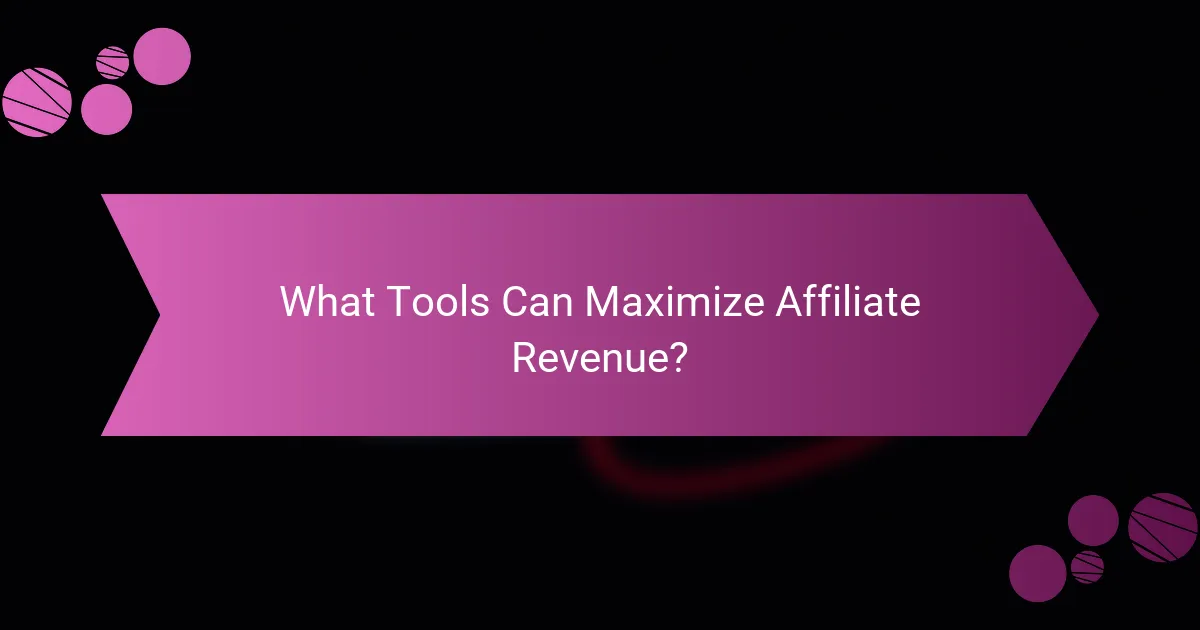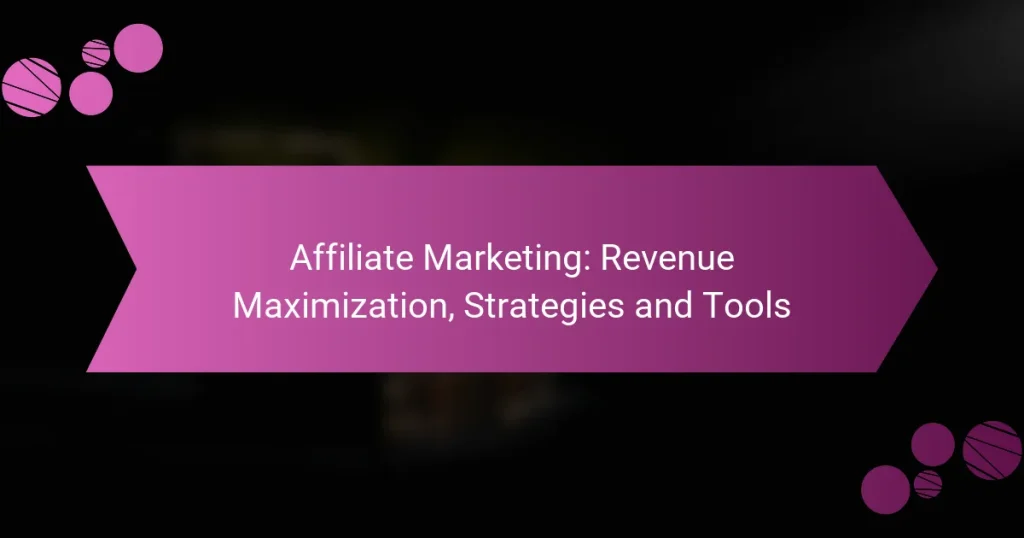Affiliate marketing offers a powerful avenue for revenue maximization through targeted strategies that effectively engage potential customers. By leveraging techniques such as content marketing, SEO, and social media promotion, marketers can enhance their outreach and conversion rates. Additionally, selecting the right affiliate programs and utilizing performance-tracking tools are critical steps in optimizing revenue potential.

What Are the Best Affiliate Marketing Strategies?
The best affiliate marketing strategies focus on maximizing revenue through targeted approaches that engage potential customers. Effective strategies include content marketing, email marketing, social media promotion, SEO optimization, and PPC advertising, each with unique strengths and considerations.
Content Marketing
Content marketing involves creating valuable, relevant content that attracts and engages your target audience. This can include blog posts, videos, infographics, and podcasts that provide useful information related to your affiliate products.
To succeed, focus on quality over quantity. Aim for well-researched articles that answer common questions or solve problems. For example, a detailed guide on using a particular product can drive traffic and encourage conversions.
Email Marketing
Email marketing is a powerful tool for nurturing leads and driving sales. By building a list of subscribers interested in your niche, you can send targeted promotions and personalized content that encourages them to click on your affiliate links.
To maximize effectiveness, segment your email list based on interests and behaviors. Use engaging subject lines and compelling calls to action. Regular newsletters with valuable insights can keep your audience engaged and increase conversion rates.
Social Media Promotion
Social media promotion leverages platforms like Facebook, Instagram, and Twitter to reach a broad audience. Sharing engaging content and affiliate links can drive traffic to your offers and increase brand awareness.
Utilize targeted ads to reach specific demographics and track engagement metrics to refine your strategy. Collaborating with influencers can also amplify your reach and credibility, especially in visually-driven platforms like Instagram.
SEO Optimization
SEO optimization focuses on improving your website’s visibility in search engine results. By using relevant keywords, optimizing meta tags, and creating high-quality backlinks, you can attract organic traffic to your affiliate offers.
Conduct keyword research to identify terms your audience is searching for, and incorporate them naturally into your content. Regularly updating your content and ensuring mobile-friendliness can also enhance your site’s performance in search rankings.
PPC Advertising
PPC advertising allows you to place ads on search engines and social media platforms, paying only when users click on your ads. This can be an effective way to quickly drive traffic to your affiliate links.
Set clear budgets and goals for your campaigns. Use A/B testing to optimize ad copy and targeting. Monitor your return on investment (ROI) closely to ensure your spending aligns with your revenue goals.

How to Choose the Right Affiliate Programs?
Choosing the right affiliate programs is crucial for maximizing revenue. Focus on factors such as commission structure, product relevance, brand reputation, and the support provided by the program to ensure a successful partnership.
Commission Structure
The commission structure defines how much you earn for each sale or action generated through your affiliate link. Look for programs that offer competitive rates, typically ranging from 5% to 50% depending on the industry and product type.
Consider whether the program offers recurring commissions or one-time payments. Recurring commissions can provide a steady income stream, especially for subscription-based products.
Product Relevance
Product relevance is essential for effective marketing. Choose affiliate programs that align with your audience’s interests and needs to increase conversion rates. For example, if your platform focuses on fitness, promoting health supplements or workout gear would be more effective than unrelated products.
Evaluate the quality and demand of the products. High-quality, in-demand products are more likely to convert and generate sales, enhancing your overall earnings.
Brand Reputation
The reputation of the brand you partner with can significantly impact your credibility. Research the brand’s history, customer reviews, and overall market presence to ensure they are trustworthy and respected.
Affiliating with reputable brands can enhance your own reputation and lead to higher conversion rates, as consumers are more likely to purchase from brands they recognize and trust.
Support and Resources
Effective affiliate programs provide robust support and resources to help you succeed. Look for programs that offer marketing materials, training, and dedicated affiliate managers to assist you in optimizing your campaigns.
Access to analytics tools can also be beneficial, allowing you to track performance and adjust your strategies accordingly. Programs that invest in their affiliates often yield better results for both parties.

What Tools Can Maximize Affiliate Revenue?
To maximize affiliate revenue, utilizing the right tools is essential for tracking performance, optimizing strategies, and enhancing conversions. Tools like Google Analytics, SEMrush, Ahrefs, and ClickFunnels provide valuable insights and functionalities that can significantly boost your affiliate marketing efforts.
Google Analytics
Google Analytics is a powerful tool for tracking website traffic and user behavior. It allows affiliate marketers to monitor which traffic sources are driving conversions, helping to identify the most effective channels for revenue generation.
By setting up goals and e-commerce tracking, you can measure the performance of your affiliate links and campaigns. Regularly analyzing this data can reveal trends and areas for improvement, enabling you to optimize your strategies effectively.
SEMrush
SEMrush is a comprehensive SEO and marketing tool that helps affiliate marketers analyze their competitors and discover profitable keywords. With its keyword research feature, you can identify high-traffic terms that can enhance your content strategy and attract more visitors.
Additionally, SEMrush offers site audit capabilities to ensure your website is optimized for search engines. Regularly using this tool can help you stay ahead of competitors and maximize your affiliate revenue potential.
Ahrefs
Ahrefs is another robust tool focused on backlink analysis and SEO performance. It provides insights into your website’s link profile and helps identify opportunities for acquiring high-quality backlinks, which can improve search rankings and drive more affiliate traffic.
Using Ahrefs, you can also track your competitors’ backlinks and content strategies, allowing you to refine your approach and capitalize on gaps in the market. This competitive analysis is crucial for maximizing affiliate revenue.
ClickFunnels
ClickFunnels is a sales funnel builder that simplifies the process of creating landing pages and sales funnels for affiliate products. It enables you to design optimized funnels that guide visitors toward making a purchase, increasing conversion rates.
With features like A/B testing and email automation, ClickFunnels allows you to refine your marketing strategies based on real-time data. Investing time in setting up effective funnels can lead to significant boosts in affiliate revenue over time.

What Are the Key Metrics for Affiliate Marketing Success?
Key metrics for affiliate marketing success include conversion rate, click-through rate, and return on investment. These metrics help assess the effectiveness of affiliate campaigns and guide optimization efforts.
Conversion Rate
The conversion rate measures the percentage of visitors who complete a desired action, such as making a purchase after clicking an affiliate link. A higher conversion rate indicates that the marketing efforts are effectively persuading users to take action.
To improve conversion rates, focus on optimizing landing pages, ensuring they are user-friendly and relevant to the audience. A typical conversion rate for affiliate marketing can range from 1% to 10%, depending on the niche and the quality of traffic.
Click-Through Rate
Click-through rate (CTR) represents the percentage of users who click on an affiliate link compared to the total number of users who view the content. A higher CTR suggests that the content is engaging and relevant to the audience.
To enhance CTR, use compelling calls to action and ensure that the affiliate links are prominently placed within the content. Average CTRs can vary widely, often falling between 1% and 5% for most affiliate campaigns.
Return on Investment
Return on investment (ROI) in affiliate marketing measures the profitability of your campaigns by comparing the revenue generated to the costs incurred. A positive ROI indicates that the affiliate program is financially beneficial.
To calculate ROI, use the formula: (Revenue – Cost) / Cost x 100. Aim for an ROI of at least 100% to ensure that your affiliate marketing efforts are worthwhile. Regularly analyze your ROI to identify which campaigns are performing best and allocate resources accordingly.

How to Optimize Affiliate Marketing Campaigns?
To optimize affiliate marketing campaigns, focus on data-driven strategies that enhance performance and increase conversions. Key methods include A/B testing, audience segmentation, and landing page optimization, each contributing to a more effective marketing approach.
A/B Testing
A/B testing involves comparing two versions of a marketing element to determine which performs better. This can include variations in ad copy, images, or calls to action. By systematically testing these elements, you can identify what resonates most with your audience.
Consider running tests over a period of weeks to gather sufficient data. Aim for a minimum of a few hundred interactions for reliable results. Common pitfalls include testing too many variables at once or not allowing enough time for the test to run.
Audience Segmentation
Audience segmentation divides your target market into distinct groups based on specific criteria such as demographics, interests, or behaviors. This allows for tailored marketing strategies that speak directly to each segment’s needs and preferences.
Utilize tools like Google Analytics or social media insights to gather data on your audience. Effective segmentation can significantly improve engagement rates, often leading to higher conversion rates. Avoid broad segmentation; instead, focus on creating smaller, more targeted groups.
Landing Page Optimization
Landing page optimization focuses on improving the design and content of your landing pages to increase conversions. Key elements include clear headlines, compelling visuals, and strong calls to action that guide visitors toward desired actions.
Ensure your landing pages load quickly, ideally within a few seconds, as slow pages can lead to high bounce rates. Test different layouts and content to see what works best for your audience. Avoid cluttered designs; a clean, straightforward layout often performs better.


